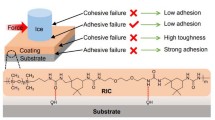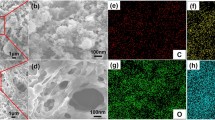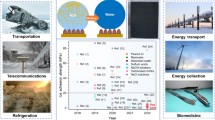Abstract
As a ubiquitous natural phenomenon, ice/frost formation on solid surfaces have adverse effects on many commercial and residential activities. Icephobic surfaces feature low ice adhesion strengths (< 100 kPa) can passively retard ice formation and ease ice removal. Superhydrophobic surfaces and liquid-lubricating surfaces are two prevailing categories of icephobic surfaces. However, their long-term stability is relatively poor, and the ice adhesion strengths are not low enough for passive removal of small ice crystals (e.g., frosts) from the surfaces. Herein, we combine the superhydrophobic and liquid-like properties in one surface to obtain durable icephobic surfaces with extremely low ice adhesion strengths (about 0.035 kPa). Ices and frosts can be removed from the surface under the action of gravity or gas purge. These surfaces are prepared based on surface nanoconical structure and covalently-grafted liquid-like perfluorinated polyether (PFPE) coating, which show synergy effects on suppressing icing and frosting by promoting expulsion of subcooled condensate droplets from the nanotexture and decreasing ice adhesion strengths. The icephobic surfaces show significantly better durability compared to lubricant-impregnated textured surfaces. Our results provide a new avenue to design passive anti-icing/anti-frosting surfaces for a wide range of applications where surfaces are exposed to humid and low-temperature environments.

Similar content being viewed by others
References
Golovin, K.; Dhyani, A.; Thouless, M. D.; Tuteja, A. Low-interfacial toughness materials for effective large-scale deicing. Science 2019, 364, 371–375.
He, Z. Y.; Wu, C. Y.; Hua, M. T.; Wu, S. W.; Wu, D.; Zhu, X. Y.; Wang, J. J.; He, X. M. Bioinspired multifunctional anti-icing hydrogel. Matter 2020, 2, 723–734.
Yang, S. Y.; Wu, C. Y.; Zhao, G. L.; Sun, J.; Yao, X.; Ma, X. H.; Wang, Z. K. Condensation frosting and passive anti-frosting. Cell Rep. Phys. Sci. 2021, 2, 100474.
Kreder, M. J.; Alvarenga, J.; Kim, P.; Aizenberg, J. Design of anti-icing surfaces: Smooth, textured or slippery? Nat. Rev. Mater. 2016, 1, 15003.
Lv, J. Y.; Yao, X.; Zheng, Y. M.; Wang, J. J.; Jiang, L. Antiadhesion organogel materials: From liquid to solid. Adv. Mater. 2017, 29, 1703032.
Wang, G. W.; Guo, Z. G. Liquid infused surfaces with anti-icing properties. Nanoscale 2019, 11, 22615–22635.
Song, M. J.; Xia, L.; Mao, N.; Deng, S. M. An experimental study on even frosting performance of an air source heat pump unit with a multi-circuit outdoor coil. Appl. Energy 2016, 164, 36–44.
Wang, F.; Liang, C. H.; Zhang, X. S. Research of anti-frosting technology in refrigeration and air conditioning fields: A review. Renewable Sustainable Energy Rev. 2018, 81, 707–722.
Zhang, S. N.; Huang, J. Y.; Cheng, Y.; Yang, H.; Chen, Z.; Lai, Y. K. Bioinspired surfaces with superwettability for anti-icing and ice-phobic application: Concept, mechanism, and design. Small 2017, 13, 1701867.
Lee, S. H.; Seong, M.; Kwak, M. K.; Ko, H.; Kang, M. S.; Park, H. W.; Kang, S. M.; Jeong, H. E. Tunable multimodal drop bouncing dynamics and anti-icing performance of a magnetically responsive hair array. ACS Nano 2018, 12, 10693–10702.
Wang, F.; Zhuo, Y. Z.; He, Z. W.; Xiao, S. B.; He, J. Y.; Zhang, Z. L. Dynamic anti-icing surfaces (DAIS). Adv. Sci. 2021, 8, 2101163.
Lv, J. Y.; Song, Y. L.; Jiang, L.; Wang, J. J. Bio-inspired strategies for anti-icing. ACS Nano 2014, 8, 3152–3169.
Yin, X. Y.; Zhang, Y.; Wang, D. A.; Liu, Z. L.; Liu, Y. P.; Pei, X. W.; Yu, B.; Zhou, F. Integration of self-lubrication and near-infrared photothermogenesis for excellent anti-icing/deicing performance. Adv. Funct. Mater. 2015, 25, 4237–4245.
Zhuo, Y. Z.; Xiao, S. B.; Amirfazli, A.; He, J. Y.; Zhang, Z. L. Polysiloxane as icephobic materials—The past, present and the future. Chem. Eng. J. 2021, 405, 127088.
Wang, T.; Zheng, Y. H.; Raji, A. R. O.; Li, Y. L.; Sikkema, W. K. A.; Tour, J. M. Passive anti-icing and active deicing films. ACS Appl. Mater. Interfaces 2016, 8, 14169–14173.
Mirzanamadi, R.; Hagentoft, C. E.; Johansson, P.; Johnsson, J. Anti-icing of road surfaces using hydronic heating pavement with low temperature. Cold Reg. Sci. Technol. 2018, 145, 106–118.
Zhuo, Y. Z.; Chen, J. H.; Xiao, S. B.; Li, T.; Wang, F.; He, J. Y.; Zhang, Z. L. Gels as emerging anti-icing materials: A mini review. Mater. Horiz. 2021, 8, 3266–3280.
Niu, W. W.; Chen, G. Y.; Xu, H. L.; Liu, X. K.; Sun, J. Q. Highly transparent and self-healable solar thermal anti-/deicing surfaces: When ultrathin MXene multilayers marry a solid slippery self-cleaning coating. Adv. Mater. 2022, 34, 2108232.
Wang, L. Z.; Tian, Z.; Jiang, G. C.; Luo, X.; Chen, C. H.; Hu, X. Y.; Zhang, H. J.; Zhong, M. L. Spontaneous dewetting transitions of droplets during icing & melting cycle. Nat. Commun. 2022, 13, 378.
Zheng, W. W.; Teng, L.; Lai, Y. K.; Zhu, T. X.; Li, S. H.; Wu, X. W.; Cai, W. L.; Chen, Z.; Huang, J. Y. Magnetic responsive and flexible composite superhydrophobic photothermal film for passive anti-icing/active deicing. Chem. Eng. J. 2022, 427, 130922.
Vazirinasab, E.; Maghsoudi, K.; Momen, G.; Jafari, R. On the icephobicity of damage-tolerant superhydrophobic bulk nanocomposites. Soft Matter 2022, 18, 412–424.
Mishchenko, L.; Hatton, B.; Bahadur, V.; Taylor, J. A.; Krupenkin, T.; Aizenberg, J. Design of ice-free nanostructured surfaces based on repulsion of impacting water droplets. ACS Nano 2010, 4, 7699–7707.
Oberli, L.; Caruso, D.; Hall, C.; Fabretto, M.; Murphy, P. J.; Evans, D. Condensation and freezing of droplets on superhydrophobic surfaces. Adv. Colloid Interface Sci. 2014, 210, 47–57.
Wang, R.; Wu, F. F.; Yu, F. F.; Zhu, J.; Gao, X. F.; Jiang, L. Anti-vapor-penetration and condensate microdrop self-transport of superhydrophobic oblique nanowire surface under high subcooling. Nano Res. 2021, 14, 1429–1434.
Shen, Y. Z.; Tao, J.; Tao, H. J.; Chen, S. L.; Pan, L.; Wang, T. Anti-icing potential of superhydrophobic Ti6Al4V surfaces: Ice nucleation and growth. Langmuir 2015, 31, 10799–10806.
Varanasi, K. K.; Hsu, M.; Bhate, N.; Yang, W. S.; Deng, T. Spatial control in the heterogeneous nucleation of water. Appl. Phys. Lett. 2009, 95, 094101.
Jung, S.; Tiwari, M. K.; Doan, N. V.; Poulikakos, D. Mechanism of supercooled droplet freezing on surfaces. Nat. Commun. 2012, 3, 615.
Boreyko, J. B.; Collier, C. P. Delayed frost growth on jumping-drop superhydrophobic surfaces. ACS Nano 2013, 7, 1618–1627.
Wang, L.; Gong, Q. H.; Zhan, S. H.; Jiang, L.; Zheng, Y. M. Robust anti-icing performance of a flexible superhydrophobic surface. Adv. Mater. 2016, 28, 7729–7735.
Kim, M. H.; Kim, H.; Lee, K. S.; Kim, D. R. Frosting characteristics on hydrophobic and superhydrophobic surfaces: A review. Energy Convers. Manag. 2017, 138, 1–11.
Nosonovsky, M.; Hejazi, V. Why superhydrophobic surfaces are not always icephobic. ACS Nano 2012, 6, 8488–8491.
Boinovich, L. B.; Emelyanenko, A. M.; Emelyanenko, K. A.; Modin, E. B. Modus operandi of protective and anti-icing mechanisms underlying the design of longstanding outdoor icephobic coatings. ACS Nano 2019, 13, 4335–4346.
Vercillo, V.; Tonnicchia, S.; Romano, J. M.; García-Girón, A.; Aguilar-Morales, A. I.; Alamri, S.; Dimov, S. S.; Kunze, T.; Lasagni, A. F.; Bonaccurso, E. Design rules for laser-treated icephobic metallic surfaces for aeronautic applications. Adv. Funct. Mater. 2020, 30, 1910268.
Cohen, N.; Dotan, A.; Dodiuk, H.; Kenig, S. Thermomechanical mechanisms of reducing ice adhesion on superhydrophobic surfaces. Langmuir 2016, 32, 9664–9675.
Chen, J.; Liu, J.; He, M.; Li, K. Y.; Cui, D. P.; Zhang, Q. L.; Zeng, X. P.; Zhang, Y. F.; Wang, J. J.; Song, Y. L. Superhydrophobic surfaces cannot reduce ice adhesion. Appl. Phys. Lett. 2012, 101, 111603.
Kulinich, S. A.; Farhadi, S.; Nose, K.; Du, X. W. Superhydrophobic surfaces: Are they really ice-repellent? Langmuir 2011, 27, 25–29.
Maitra, T.; Jung, S.; Giger, M. E.; Kandrical, V.; Ruesch, T.; Poulikakos, D. Superhydrophobicity vs. ice adhesion:The quandary of robust icephobic surface design. Adv. Mater. Interfaces 2015, 2, 1500330.
Jung, S.; Dorrestijn, M.; Raps, D.; Das, A.; Megaridis, C. M.; Poulikakos, D. Are superhydrophobic surfaces best for icephobicity? Langmuir 2011, 27, 3059–3066.
Wong, T. S.; Kang, S. H.; Tang, S. K. Y.; Smythe, E. J.; Hatton, B. D.; Grinthal, A.; Aizenberg, J. Bioinspired self-repairing slippery surfaces with pressure-stable omniphobicity. Nature 2011, 477, 443–447.
Hauer, L.; Wong, W. S. Y.; Donadei, V.; Hegner, K. I.; Kondic, L.; Vollmer, D. How frost forms and grows on lubricated micro- and nanostructured surfaces. ACS Nano 2021, 15, 4658–4668.
Irajizad, P.; Hasnain, M.; Farokhnia, N.; Sajadi, S. M.; Ghasemi, H. Magnetic slippery extreme icephobic surfaces. Nat. Commun. 2016, 7, 13395.
Han, G.; Nguyen, T. B.; Park, S.; Jung, Y.; Lee, J.; Lim, H. Moth-eye mimicking solid slippery glass surface with icephobicity, transparency, and self-healing. ACS Nano 2020, 14, 10198–10209.
Villegas, M.; Zhang, Y. X.; Jarad, N. A.; Soleymani, L.; Didar, T. F. Liquid-infused surfaces: A review of theory, design, and applications. ACS Nano 2019, 13, 8517–8536.
Urata, C.; Hönes, R.; Sato, T.; Kakiuchida, H.; Matsuo, Y.; Hozumi, A. Textured organogel films showing unusual thermoresponsive dewetting, icephobic, and optical properties. Adv. Mater. Interfaces 2019, 6, 1801358.
Zhuo, Y. Z.; Xiao, S. B.; Håkonsen, V.; He, J. Y.; Zhang, Z. L. Anti-icing ionogel surfaces: Inhibiting ice nucleation, growth, and adhesion. ACS Materials Lett. 2020, 2, 616–623.
Li, T.; nmnez-Ibanez, P. F.; Håkonsen, V.; Wu, J. Y.; Xu, K.; Zhuo, Y. Z.; Luo, S. H.; He, J. Y.; Zhang, Z. L. Self-deicing electrolyte hydrogel surfaces with Pa-level ice adhesion and durable antifreezing/antifrost performance. ACS Appl. Mater. Interfaces 2020, 12, 35572–35578.
Shen, J. D.; Du, P.; Zhou, B. B.; Zhang, G. B.; Tang, X. X.; Pan, J.; Li, B.; Zhang, J. Y.; Lu, J.; Li, Y. Y. An anti-freezing biomineral hydrogel of high strain sensitivity for artificial skin applications. Nano Res. 2022, 15, 6655–6661.
Lu, Y.; Qu, X. Y.; Wang, S. Y.; Zhao, Y.; Ren, Y. F.; Zhao, W. L.; Wang, Q.; Sun, C. C.; Wang, W. J.; Dong, X. C. Ultradurable, freeze-resistant, and healable MXene-based ionic gels for multi-functional electronic skin. Nano Res. 2022, 15, 4421–4430.
Kim, P.; Wong, T. S.; Alvarenga, J.; Kreder, M. J.; Adorno-Martinez, W. E.; Aizenberg, J. Liquid-infused nanostructured surfaces with extreme anti-ice and anti-frost performance. ACS Nano 2012, 6, 6569–6577.
Li, J. S.; Ueda, E.; Paulssen, D.; Levkin, P. A. Slippery lubricant-infused surfaces: Properties and emerging applications. Adv. Funct. Mater. 2019, 29, 1802317.
Dong, Z. Q.; Schumann, M. F.; Hokkanen, M. J.; Chang, B.; Welle, A.; Zhou, Q.; Ras, R. H. A.; Xu, Z. L.; Wegener, M.; Levkin, P. A. Superoleophobic slippery lubricant-infused surfaces: Combining two extremes in the same surface. Adv. Mater. 2018, 30, 1803890.
Ozbay, S.; Yuceel, C.; Erbil, H. Y. Improved icephobic properties on surfaces with a hydrophilic lubricating liquid. ACS Appl. Mater. Interfaces 2015, 7, 22067–22077.
Beemer, D. L.; Wang, W.; Kota, A. K. Durable gels with ultra-low adhesion to ice. J. Mater. Chem. A 2016, 4, 18253–18258.
Zheng, H. L.; Liu, G. J.; Nienhaus, B. B.; Buddingh, J. V. Ice-shedding polymer coatings with high hardness but low ice adhesion. ACS Appl. Mater. Interfaces 2022, 14, 6071–6082.
Huang, S. L.; Li, J.; Liu, L.; Zhou, L. D.; Tian, X. L. Lossless fast drop self-transport on anisotropic omniphobic surfaces: Origin and elimination of microscopic liquid residue. Adv. Mater. 2019, 31, 1901417.
Zhang, L.; Guo, Z. Q.; Sarma, J.; Zhao, W. W.; Dai, X. M. Gradient quasi-liquid surface enabled self-propulsion of highly wetting liquids. Adv. Funct. Mater. 2021, 31, 2008614.
Wang, L. M.; McCarthy, T. J. Covalently attached liquids: Instant omniphobic surfaces with unprecedented repellency. Angew. Chem., Int. Ed. 2016, 55, 244–248.
Zhao, X. X.; Khatir, B.; Mirshahidi, K.; Yu, K.; Kizhakkedathu, J. N.; Golovin, K. Macroscopic evidence of the liquidlike nature of nanoscale polydimethylsiloxane brushes. ACS Nano 2021, 15, 13559–13567.
Zhang, L.; Guo, Z. Q.; Sarma, J.; Dai, X. M. Passive removal of highly wetting liquids and ice on quasi-liquid surfaces. ACS Appl. Mater. Interfaces 2020, 12, 20084–20095.
Tian, J.; Zhu, J.; Guo, H. Y.; Li, J.; Feng, X. Q.; Gao, X. F. Efficient self-propelling of small-scale condensed microdrops by closely packed ZnO nanoneedles. J. Phys. Chem. Lett. 2014, 5, 2084–2088.
Gong, X. J.; Gao, X. F.; Jiang, L. Recent progress in bionic condensate microdrop self-propelling surfaces. Adv. Mater. 2017, 29, 1703002.
Lafuma, A.; Quéré, D. Superhydrophobic states. Nat. Mater. 2003, 2, 457–460.
Sarshar, M. A.; Song, D.; Swarctz, C.; Lee, J.; Choi, C. H. Anti-icing or deicing: Icephobicities of superhydrophobic surfaces with hierarchical structures. Langmuir 2018, 34, 13821–13827.
Pan, R.; Zhang, H. J.; Zhong, M. L. Triple-scale superhydrophobic surface with excellent anti-icing and icephobic performance via ultrafast laser hybrid fabrication. ACS Appl. Mater. Interfaces 2021, 13, 1743–1753.
Wang, P.; Li, Z. Q.; Xie, Q.; Duan, W.; Zhang, X. C.; Han, H. L. A passive anti-icing strategy based on a superhydrophobic mesh with extremely low ice adhesion strength. J. Bionic Eng. 2021, 18, 55–64.
Lo, T. N. H.; Lee, J.; Hwang, H. S.; Park, I. Nanoscale coatings derived from fluoroalkyl and PDMS alkoxysilanes on rough aluminum surfaces for improved durability and anti-icing properties. ACS Appl. Nano Mater. 2021, 4, 7493–7501.
Shen, Y. Z.; Wu, Y.; Tao, J.; Zhu, C. L.; Chen, H. F.; Wu, Z. W.; Xie, Y. H. Spraying fabrication of durable and transparent coatings for anti-icing application: Dynamic water repellency, icing delay, and ice adhesion. ACS Appl. Mater. Interfaces 2019, 11, 3590–3598.
Gao, J.; Zhang, Y. F.; Wei, W.; Yin, Y.; Liu, M. H.; Guo, H.; Zheng, C. B.; Deng, P. Y. Liquid-infused micro-nanostructured MOF coatings (LIMNSMCs) with high anti-icing performance. ACS Appl. Mater. Interfaces 2019, 11, 47545–47552.
Juuti, P.; Haapanen, J.; Stenroos, C.; Niemelä-Anttonen, H.; Harra, J.; Koivuluoto, H.; Teisala, H.; Lahti, J.; Tuominen, M.; Kuusipalo, J. et al. Achieving a slippery, liquid-infused porous surface with anti-icing properties by direct deposition of flame synthesized aerosol nanoparticles on a thermally fragile substrate. Appl. Phys. Lett. 2017, 110, 161603.
Liu, C.; Li, Y. L.; Lu, C. G.; Liu, Y.; Feng, S. L.; Liu, Y. H. Robust slippery liquid-infused porous network surfaces for enhanced anti-icing/deicing performance. ACS Appl. Mater. Interfaces 2020, 12, 25471–25477.
Urata, C.; Dunderdale, G. J.; England, M. W.; Hozumi, A. Self-lubricating organogels (SLUGs) with exceptional syneresis-induced anti-sticking properties against viscous emulsions and ices. J. Mater. Chem. A 2015, 3, 12626–12630.
Wang, Y. L.; Yao, X.; Chen, J.; He, Z. Y.; Liu, J.; Li, Q. Y.; Wang, J. J.; Jiang, L. Organogel as durable anti-icing coatings. Sci. China Mater. 2015, 58, 559–565.
Urata, C.; Nagashima, H.; Hatton, B. D.; Hozumi, A. Transparent organogel films showing extremely efficient and durable anti-icing performance. ACS Appl. Mater. Interfaces 2021, 13, 28925–28937.
Yu, Y. N.; Jin, B. Y.; Jamil, M. I.; Cheng, D. G.; Zhang, Q. H.; Zhan, X. L.; Chen, F. Q. Highly stable amphiphilic organogel with exceptional anti-icing performance. ACS Appl. Mater. Interfaces 2019, 11, 12838–12845.
Golovin, K.; Kobaku, S. P. R.; Lee, D. H.; DiLoreto, E. T.; Mabry, J. M.; Tuteja, A. Designing durable icephobic surfaces. Sci. Adv. 2016, 2, e1501496.
He, Z. W.; Xiao, S. B.; Gao, H. J.; He, J. Y.; Zhang, Z. L. Multiscale crack initiator promoted super-low ice adhesion surfaces. Soft Matter 2017, 13, 6562–6568.
Xu, Q.; Li, J.; Tian, J.; Zhu, J.; Gao, X. F. Energy-effective frost-free coatings based on superhydrophobic aligned nanocones. ACS Appl. Mater. Interfaces 2014, 6, 8976–8980.
Wang, R.; Wu, F. F.; Xing, D. D.; Yu, F. F.; Gao, X. F. Density maximization of one-step electrodeposited copper nanocones and dropwise condensation heat-transfer performance evaluation. ACS Appl. Mater. Interfaces 2020, 12, 24512–24520.
Zhu, J.; Luo, Y. T.; Tian, J.; Li, J.; Gao, X. F. Clustered ribbed-nanoneedle structured copper surfaces with high-efficiency dropwise condensation heat transfer performance. ACS Appl. Mater. Interfaces 2015, 7, 10660–10665.
Lecointre, P.; Laney, S.; Michalska, M.; Li, T.; Tanguy, A.; Papakonstantinou, I.; Quéré, D. Unique and universal dew-repellency of nanocones. Nat. Commun. 2021, 12, 3458.
Mouterde, T.; Lehoucq, G.; Xavier, S.; Checco, A.; Black, C. T.; Rahman, A.; Midavaine, T.; Clanet, C.; Quéré, D. Antifogging abilities of model nanotextures. Nat. Mater. 2017, 16, 658–663.
Liu, Y. H.; Moevius, L.; Xu, X. P.; Qian, T. Z.; Yeomans, J. M.; Wang, Z. K. Pancake bouncing on superhydrophobic surfaces. Nat. Phys. 2014, 10, 515–519.
Li, J.; Luo, Y. T.; Zhu, J.; Li, H.; Gao, X. F. Subcooled-water nonstickiness of condensate microdrop self-propelling nanosurfaces. ACS Appl. Mater. Interfaces 2015, 7, 26391–26395.
Acknowledgements
We acknowledge the financial support from National Natural Science Foundation of China (Nos. 22072185, 12072381, 21872176, and 21805315), Pearl River Talents Program (No. 2017GC010671), Natural Science Foundation of Guangdong Province (No. 2019A1515012030), and Science and Technology Innovation Project of Guangzhou (No. 202102020263).
Author information
Authors and Affiliations
Corresponding authors
Rights and permissions
About this article
Cite this article
Ouyang, M., Guo, R., Fan, Y. et al. Ultralow-adhesion icephobic surfaces: Combining superhydrophobic and liquid-like properties in the same surface. Nano Res. 16, 589–598 (2023). https://doi.org/10.1007/s12274-022-4746-z
Received:
Revised:
Accepted:
Published:
Issue Date:
DOI: https://doi.org/10.1007/s12274-022-4746-z




